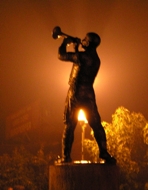
www.guca.rs
FolkWorld Issue 43 11/2010; Article from Wikipedia, the free encyclopedia
 www.guca.rs |
In 2010, the annual Guča brass festival in western Serbia was celebrating its 50th anniversary. Half a million visitors, both from Serbia and abroad, made their way to the small town of Guča for the wildest and most frenetic event of its kind.

|
Republic of Serbia (Република |
Serbia has a variety of traditional music, which is part of the wider Balkan tradition, with its own distinctive sound and characteristics.
The documented musical history of the Serbs can be traced back to the medieval era. Church music was performed throughout Serbia by choirs or individual singers. The songs performed at the time were derived from the Osmoglasnik, a collection of religious songs dedicated to Jesus. These songs were repeated over the course of eight weeks in a cyclical fashion. Composers from this era include Stefan Srbin, Isaija Srbin, and Nikola Srbin.
Aside from church music, the medieval era in Serbia included traditional music, about which little is known, and court music. During the rule of the House of Nemanjić musicians played an important role in the royal court, and were known as sviralnici, glumci and praskavnici. The rulers known for the musical patronage included Stefan Dušan and Đurađ Branković.
With the fall of Serbia under the Ottoman rule came instruments that would further cause Serbian music to flourish.
Medieval musical instruments included horns, trumpets, lutes, psalteries, drums and cymbals. Traditional folk instruments include the gajde, kaval, dajre, diple, tamburitza, gusle, tapan (davul), sargija, ćemane (kemenche), zurla (zurna), and frula among others.
Traditional Serbian music include various kinds of bagpipes, flutes, horns, trumpets, lutes, psalteries, drums and cymbals such as:
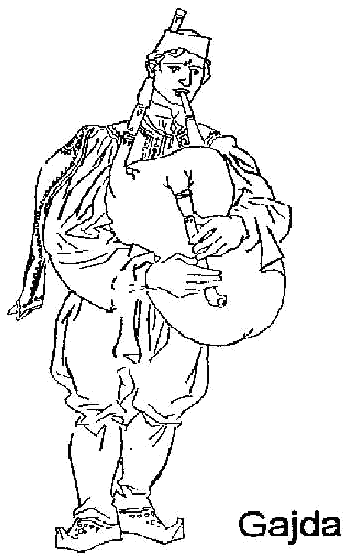
The genre encompasses both vocal and non-vocal (instrumental).
Balkanika, Balkanopolis, Dvig, Slobodan Trkulja, Belo Platno, Teodulija, Kulin Ban are known Serbian musical groups that use traditional Balkan musical instruments and perform traditional songs and songs based on traditional music elements.
Sung epic poetry has been an integral part of Serbian and Balkan music for centuries (Serbian epic poetry). In the highlands of Serbia and Montenegro these long poems are typically accompanied on a one-string fiddle called the gusle, and concern themselves with themes from history and mythology.
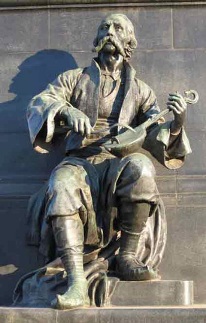 Serbian folk music
Serbian folk musicToday the Serbian folk music is both rural (izvorna muzika) and urban (starogradska muzika) and includes a two-beat dance called kolo, which is a circle dance with almost no movement above the waist, accompanied by instrumental music made most often with an accordion, but also with other instruments: frula (traditional kind of a recorder), tamburica, or accordion. The Kolos usually last for about 5-13 minutes. Modern accordionists include Mirko Kodić and Ljubiša Pavković.
The Banat region in northern Serbia and western Romania (Timiş County) is a culture zone of Serbs and Romanians which can be seen in the culture (folk attire, dance, music) of the region.
The so called "novokomponovana muzika" (newly composed music) can be seen as a result of the urbanization of folk music. In its early times, it had a professional approach to performance, used accordion and clarinet and typically included love songs or other simple lyrics (though there have long been royalist and anti-Communist lyrical themes persisting underground). Many of the genre's best performers also play forms imported from even further abroad. These include Šaban Šaulić, Toma Zdravković, Silvana Armenulic and. At a later stage, the popular performers such as Lepa Brena, Vesna Zmijanac and Dragana Mirković used more influences from pop music, oriental music, and other genres, which led to the emergence of turbo folk.
Čoček is a musical genre and belly dance that emerged in the Balkans during the early 19th century. Čoček originated from Ottoman military bands, which at that time were scattered across the region, mostly throughout Bulgaria, Serbia, Macedonia and Romania. That led to the eventual segmentation and wide range of ethnic sub-styles in čoček. The Serbian čoček is more popular in south Serbia and differs slightly to Bulgarian čoček, which has more oriental sound.
Turbo-folk (a term coined by rock musician Rambo Amadeus) music emerged during Yugoslav wars and breakup of Yugoslavia. Turbo-folk used Serbian folk music and "novokomponovana" as the basis, and added influences from rock, pop and electronic dance music. In the 2000s turbo-folk featured even more pop music elements, and some of the performers were labeled as pop-folk. Some of the best known turbo-folk perfromers include Seka Aleksić, Jelena Karleuša, Aca Lukas, Ceca Ražnatović, Dragana Mirković and others.
Balkan Brass Band (Serbian: Труба, trumpet) is a distinctive style of music originating in 19th century Serbia when trumpeters in the military transposed Folk music during harsh times. It is popular throughout the Balkans, especially Serbia, Macedonia and Bulgaria. The beats are usually fast and accompanied by kolo (dance). The performers each have their instrument of the orchestra and are called trubači (трубачи). The best known examples of acclaimed music in this style are from Goran Bregović and Boban Marković Orkestar. The Serbian film maker Emir Kusturica has, through his films (Black Cat, White Cat), made the style popular in the international community outside the Balkans.
The biggest brass band event in the world Guča trumpet festival is a 5-day annual festival with 300 000 visitors, in Guča, Serbia.
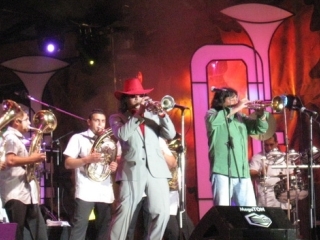 Boban i Marko Markovic @ FolkWorld: |
A brass band is primarily made up of a large number of musicians playing brass instruments such as flugelhorns, trumpets, alto horns, helicons, euphoniums, tenor horns, tubas, baritone horns and sometimes trombones. Percussion is provided by snare drum and bass drums, traditionally davuls (also known as tapan or goč) carried by the performers.
The music is usually instrumental although sometimes accompanied with singing. Common song forms include the čoček and the Kolo.
Balkan Brass music has had a major impact on the world music scene. Introduced to western audiences through the films of Emir Kusturica featuring soundtracks by Goran Bregovic, it soon spread to European dancefloors spearheaded by DJ Robert Soko's "Balkan Beats" parties in Berlin, Germany.
Traditional bands from the Balkans like the Boban Marković Orkestar and Fanfare Ciocărlia garnered worldwide attention while new bands like New York-based Balkan Beat Box or the Amsterdam Klezmer Band fused the Balkan sound with other genres like Klezmer or Ska. DJs and producers, most prominently Shantel from Germany, successfully mixed Balkan Brass with electronic beats.
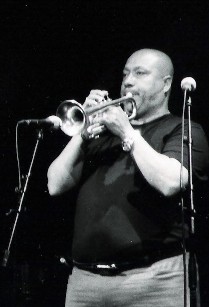
The Guča trumpet festival, also known as the Dragačevo Assembly (Serbian: Драгачевски сабор or Dragačevski sabor), is an annual brass band festival held in the town of Guča, near the city of Čačak, in the Dragačevo region of western Serbia. Guča is a three-hour bus journey from Belgrade.
600,000 visitors make their way to the town of 2,000 people every year, both from Serbia and abroad. Elimination heats earlier in the year mean only a few dozen bands get to compete. Guča's official festival is split into three parts. Friday's opening concert, Saturday night celebrations and Sunday's competition. Friday's concerts are held at the entrance to the official Guča Festival building. This event features previous winners, each band getting to play three tunes while folk dancers, all kitted out in bright knitting patterns, dance kolos and oros in front of a hyped-up audience.
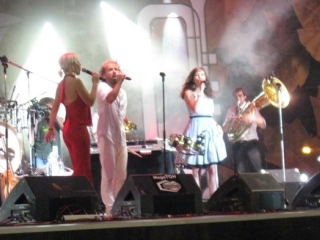 Shantel @ FolkWorld: FW#35, #40
|
| “ | Forget Glastonbury, Reading, Burning Man and Coachella: the wildest music festival on earth is a cacophonic and crazy brass band festival that takes place every summer in the tiny Serbian town of Guča in the western region of Dragačevo. | ” |
Said Miles Davis, a Guča Festival visitor:
| “ | I didn't know you could play trumpet that way | ” |
The next festival will take place 13 – 22 August 2010. The organizers issued an official call to the presidents of Russia and U.S., Dmitry Medvedev and Barack Obama, and Russian Prime Minister Vladimir Putin, to attend the next year's 50th anniversary event, when the festival will bring together trumpeters from across the globe. Festival Committee chairman Slobodan Jolović said he expects Serbian President Boris Tadić to open the festival next year.
The village of Guča has gained world fame owing to its Assembly of Trumpet Players, the largest trumpet event on the planet. The love of the people of Dragačevo for music, especially for the trumpet, began in the rule of Prince Miloš Obrenović, who ordered the formation of the first military band in 1831. From then until now the trumpet has reigned here uninterrupted while woodwind instruments, in keeping with the customs, warm the soul of its population.
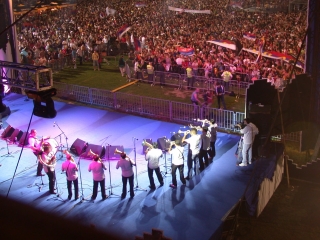 The sound of the trumpet traditionally accompanies every major event in Serbia's rural and small-town life: births, baptisms, weddings, Slavas {family patron saint day}, farewell parties for those joining military service, state and church festivals, harvesting, reaping, and also departing this world. Appropriate music is played on these occasions, thus preserving the spirit of the existing tradition. The music is very diverse: from indigenous melodies, via kolo {a fast-rhythm chain dance}, marches and characteristic southern Serbia čoček dances, all the way to tunes that have emerged more recently, but always taking care to honor old harmonies. This music has won over the hearts of not only the local population, but has also warmed the hearts of outsiders and foreigners. In the several days of the Guča festival, hardly anyone can resist giving themselves to the adrenalin-rushing rhythms and melodies that simply force one to jump to ones feet and dance.
The sound of the trumpet traditionally accompanies every major event in Serbia's rural and small-town life: births, baptisms, weddings, Slavas {family patron saint day}, farewell parties for those joining military service, state and church festivals, harvesting, reaping, and also departing this world. Appropriate music is played on these occasions, thus preserving the spirit of the existing tradition. The music is very diverse: from indigenous melodies, via kolo {a fast-rhythm chain dance}, marches and characteristic southern Serbia čoček dances, all the way to tunes that have emerged more recently, but always taking care to honor old harmonies. This music has won over the hearts of not only the local population, but has also warmed the hearts of outsiders and foreigners. In the several days of the Guča festival, hardly anyone can resist giving themselves to the adrenalin-rushing rhythms and melodies that simply force one to jump to ones feet and dance.
The traditional Dragačevo trumpet - its cult kept alive for nearly two centuries regardless of political and social considerations - has with time become world-renowned. It is owing to the trumpet that the name of Serbia has resounded worldwide, in all the continents. Some orchestras, when they appear on stage, whether for official competition national dress, the authentic and indigenous dances and other folk-inspired elements, coupled with music, have become an integral part of national gathering. The virtuoso music performers, the trumpet players to the paradox and make the story more authentic - are for the most part fully self-taught. They play by ear and quite spontaneously, relying on their musical memory; they play from the heart and soul, and their music reaches out to listeners precisely for this quality. The Guča Assembly of Trumpet Players continues to grow year after year: today, this musical feast of recognizable national skills is more popular, more diverse and bigger than ever before.
The first Dragačevo Assembly of Trumpet Players was held on October 16, 1961 in the yard of the Church of Sts. Michael and Gabriel in Guča. Initially, it was a very modest Assembly - almost subversive for the prevailing political circumstances of that time. However, the Assembly gradually grew and expanded its, one might say, magical influence, and over the past ten or so years has become the folk remained its key symbol and raison d'etre, it is no longer held solely for the trumpet players. It grew into an Assembly of toastmasters, painters, song "Sa Ovčara i Kablara", marks the beginning of the festival each year. Some church music festivals notwithstanding, the Assembly of Trumpet Players is the best know event of this kind extending uninterruptedly for 43 years and attracting guests and musicians alike from every continent. Trumpet players and folk song and dance groups from around the world deem it a great honor to be invited to the Assembly, and the number of visitors increases with each coming year.
With considerable experience in organizing Assemblies, today the traditionally hospitable Guča has earned its place on the map of world music festivals, inviting high interest from ethno music lovers, and deservedly so. As an internationally recognized trumpet capital, and a singular corner of positive energy, a place with accumulated joy, gaiety and spontaneity, coupled with the piercing yet gentle sound of the trumpet, Guča is a place of catharsis of the heart and soul while the festival lasts. All this is more than enough to attract visitors to Guča from Mexico, Spain, Greece, Denmark, China and other countries. The names of Boban Marković, Ekrem Sajdić, Elvis Ajdinović, Fejat and Zoran Sejdić have carried the glory of the Serbian trumpet across the world.
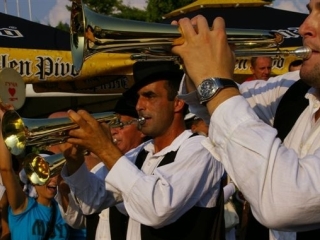
| “ | Guča represents in a best way what Serbia is today, what does its openness, belief in oneself, hospitality, party and music. [The] trumpet festival is a confirmation on our courage and joy both in good and bad times. It represents people's return to the roots, joy and meaning of life. It speaks about who we are, what we are, our urges. We express our joy and sadness with [the] trumpet, we are born with sounds of [the] trumpet, and also buried with sounds of [the] trumpet. Guča is [a] Serbian brand, it's a value that can represent Serbia in the world. Those that can’t understand and love Guča, can’t understand Serbia. If we are going to go in [the] EU without our melodies and colours, then we wouldn’t know who we are. | ” |

 From Wikipedia, the free encyclopedia
[en.wikipedia.org/wiki/Music_of_Serbia,
en.wikipedia.org/wiki/Balkan_Brass_Band,
en.wikipedia.org/wiki/Gu%C4%8Da_trumpet_festival].
From Wikipedia, the free encyclopedia
[en.wikipedia.org/wiki/Music_of_Serbia,
en.wikipedia.org/wiki/Balkan_Brass_Band,
en.wikipedia.org/wiki/Gu%C4%8Da_trumpet_festival].All text is available under the terms of the GNU Free Documentation License. Date: October 2010. |
Photo Credits:
(1) Guča Statue,
(4) Filip Višnjić @ Kruševac monument,
(11) Wikipedia Logo
(by Wikipedia);
(2) Guča Festival 2009
(5) Boban i Marko Markovic
(7) Shantel
(8)-(9) Guča Festival 2009
(by Guca.rs);
(3) Gajda performer (by Radio Tirana);
(6) King Naat Veliov, Kocani Orkestar
(by Adolf 'gorhand' Goriup);
(10) GNU Logo (by GNU Project).
|
To the German FolkWorld |
© The Mollis - Editors of FolkWorld; Published 11/2010
All material published in FolkWorld is © The Author via FolkWorld. Storage for private use is allowed and welcome. Reviews and extracts of up to 200 words may be freely quoted and reproduced, if source and author are acknowledged. For any other reproduction please ask the Editors for permission. Although any external links from FolkWorld are chosen with greatest care, FolkWorld and its editors do not take any responsibility for the content of the linked external websites.
